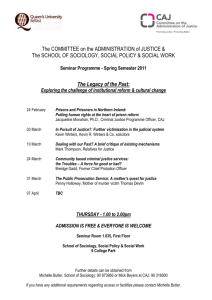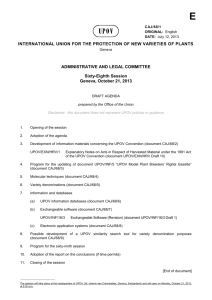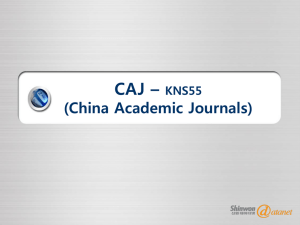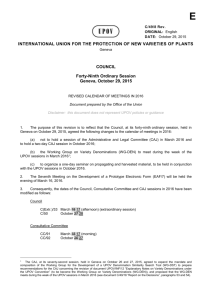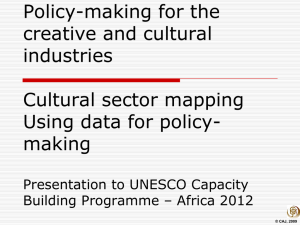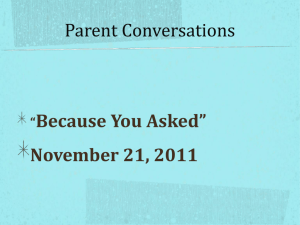CAJ 07-26-07 Interview with Greg Larson
advertisement
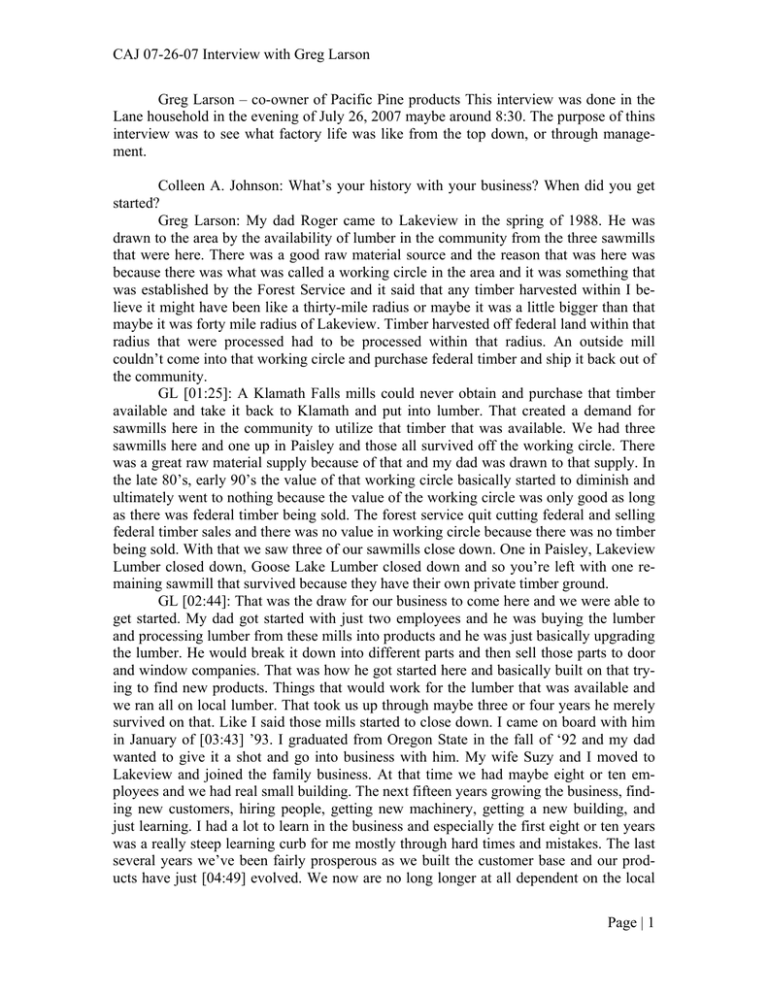
CAJ 07-26-07 Interview with Greg Larson Greg Larson – co-owner of Pacific Pine products This interview was done in the Lane household in the evening of July 26, 2007 maybe around 8:30. The purpose of thins interview was to see what factory life was like from the top down, or through management. Colleen A. Johnson: What’s your history with your business? When did you get started? Greg Larson: My dad Roger came to Lakeview in the spring of 1988. He was drawn to the area by the availability of lumber in the community from the three sawmills that were here. There was a good raw material source and the reason that was here was because there was what was called a working circle in the area and it was something that was established by the Forest Service and it said that any timber harvested within I believe it might have been like a thirty-mile radius or maybe it was a little bigger than that maybe it was forty mile radius of Lakeview. Timber harvested off federal land within that radius that were processed had to be processed within that radius. An outside mill couldn’t come into that working circle and purchase federal timber and ship it back out of the community. GL [01:25]: A Klamath Falls mills could never obtain and purchase that timber available and take it back to Klamath and put into lumber. That created a demand for sawmills here in the community to utilize that timber that was available. We had three sawmills here and one up in Paisley and those all survived off the working circle. There was a great raw material supply because of that and my dad was drawn to that supply. In the late 80’s, early 90’s the value of that working circle basically started to diminish and ultimately went to nothing because the value of the working circle was only good as long as there was federal timber being sold. The forest service quit cutting federal and selling federal timber sales and there was no value in working circle because there was no timber being sold. With that we saw three of our sawmills close down. One in Paisley, Lakeview Lumber closed down, Goose Lake Lumber closed down and so you’re left with one remaining sawmill that survived because they have their own private timber ground. GL [02:44]: That was the draw for our business to come here and we were able to get started. My dad got started with just two employees and he was buying the lumber and processing lumber from these mills into products and he was just basically upgrading the lumber. He would break it down into different parts and then sell those parts to door and window companies. That was how he got started here and basically built on that trying to find new products. Things that would work for the lumber that was available and we ran all on local lumber. That took us up through maybe three or four years he merely survived on that. Like I said those mills started to close down. I came on board with him in January of [03:43] ’93. I graduated from Oregon State in the fall of ‘92 and my dad wanted to give it a shot and go into business with him. My wife Suzy and I moved to Lakeview and joined the family business. At that time we had maybe eight or ten employees and we had real small building. The next fifteen years growing the business, finding new customers, hiring people, getting new machinery, getting a new building, and just learning. I had a lot to learn in the business and especially the first eight or ten years was a really steep learning curb for me mostly through hard times and mistakes. The last several years we’ve been fairly prosperous as we built the customer base and our products have just [04:49] evolved. We now are no long longer at all dependent on the local Page | 1 CAJ 07-26-07 Interview with Greg Larson raw material resource. We have not purchased lumber from local mills for maybe two years. All our lumber comes from outside the area and brought in either by rail from Wisconsin or by ocean going freight from South America or Chili, New Zealand. We bring it into San Francisco or Portland and bring by truck from there or probably about half of our wood comes from the Willamette valley or Washington, the coast of Washington and some British Columbia. CAJ [05:35]: Is the reason you don’t use local wood because it’s not as high quality or is it because it’s hard to get? GL: The value has diminished. The local sawmill primarily cuts ponderosa pine and it’s mostly a fairly low grade of ponderosa pine because the big trees aren’t being cut anymore so that grade of pine does not lend itself to products that we can make money on. It’s just not as desirable. CAJ [06:10]: Like high quality products that you need to sell? GL: It’s going to be used for treated wood or framing wood. We are running more higher value hardwood, clear hardwood, a tremendous amount of alder that’s coming out of the Willamette valley and that’s just because that’s where that grows is over on the coast GL [06:35]: We’re running a lot of that, over half of our volume. That’s a species that the market has transitioned with the supply availability of lumber. If you could go back twenty or thirty years there used to be just a tremendous amount of Douglas fir sawmills and pine sawmills and there was just huge volumes of that cut and so that hence of course was what was supplied to the market and so you saw a lot of pine doors and Doug fir mill [07:10] work. As that supply dwindled the market went to other things and now it’s alder off the coast because again the supply and hardwoods from the east which are in still abundantly supplied. The markets have changed to the resource availability. Our market, the pine market just isn’t there anymore for us. CAJ: Is that because of environmental concessions, like cutting for federal lands? GL: Yah, there was a tremendous amount of pressure put on the forester for various reasons mostly environmental issues, law suits that when the foresters kept getting sued for all the timber sales that they were putting up, then they quit putting timber sales up [08:00] and it just all came to an end. The Clinton administration came in there and put restrictions on it and so basically you just saw an agency that was in business to sell timber is now they’re in business to do environment assessments on what they have out there. A lot of that time of thing so it’s just significantly changed in the last fifteen years and the resources out there is just not looked at the same and is not being utilized. GL [08:45]: The result is that you will find in eastern Oregon possibly four or five sawmills remaining in all of eastern Oregon and there used to be literally just, I mean we had three in our own town here. Every town had at least one, maybe two or three and now you might find five on the whole east part of the state. It’s really been a changing thing, which has changed economics of course. CAJ: Who do you sell your products to? GL [09:30]: We sell about 70% of our products are door components so there parts of doors that would then be assembled by other door companies to make a wood door and that is about 70% of our business and it is going to fairly large door companies located all over the United States. We do business in southern California, Phoenix, Arizona market’s good, [10:00] Wisconsin has been good to us, some on the east coast, a Page | 2 CAJ 07-26-07 Interview with Greg Larson little bit here in Oregon and Washington. So those are components that go out all over the U.S. and then maybe 30% of our business is taking those components and building a finished custom wood door. So basically we’re building a door out of components that we would otherwise sell to other companies. The doors get sold basically local and by local I mean within a 300 mile radius, we don’t ship doors to southern California, actually we did do a Hawaii job. GL [10:45]: We just finished up the Hilton in Honolulu, but for the most part our doors stay in the 300 mile radius, Northern California, Oregon, Washington. CAJ: Nevada? GL: We sell a few in Nevada. There’s not a lot of construction is Nevada that the type that would use our product. Our products mostly go into some really high-end homes. It’s an expensive high-end product that you will find in probably a $700,000 home and up, generally. And our doors are sold to usually contractors, or sometimes even homeowners through retail stores. CAJ: Do you know any stores that carry? GL: yes, we service, we’re carried in all the Gel-Wen retail stores in Oregon, all our wood door custom wood doors. That’s Bend, Portland, and Medford and then we have [12:00] our own retail store that we own down in Lake Tahoe. We have our own employees that run that store and they sell our own doors and other house trim packages out of that regional store. CAJ: And it is called Pacific Pine Products? GL: That’s called High Sierra Custom Door and it’s a division of Pacific Pine Products. CAJ [12:30]: I overheard that you do trim too? GL: Yes, and through our Truckee store, that’s the actual town our store is in down there, we do trim pack, which is like base trim, casing trim, lid material, which is like this, all that trim which is all that wood on the ceiling. It’s all paneling, it’s tongue and groove paneling. We do a lot of that and that goes into the Tahoe market and that’s really [13:00] big on, it’s a mountain setting so you have a lot of rustic mountain houses that use a lot of wood and they’re really into the natural wood. The natural look so that’s a lot of that market down there, that’s where our product goes. Central Oregon is big on that too. We sell a lot of that in the Central Oregon market. CAJ [13:30]: How many employees do you currently have? GL: Probably about 55. We run two shifts. CAJ: Day and swing? GL: Yes. CAJ: How do pick your employees? GL: A lot of times it’s word of mouth. If we need somebody we get the word out and usually someone will know someone that’s looking for a job. We have a lot of people working for us that are either brothers or cousins or relatives of some sort that just come through word of mouth and that’s been real successful for us. Once in a while you just get lucky on a random walk-in or we also do soliciting through the unemployment office or COIC, which stands for Central Oregon Intergovernmental Council. They are an employment base, job search type of thing. I can do a job listing through them, which they post in Bend, Redmond, Klamath Falls and cover a broad area. We’ve picked up some people through that. Page | 3 CAJ 07-26-07 Interview with Greg Larson CAJ: Are they union? GL: Non-union. CAJ: May I ask how much they get paid? GL [15:00]: It just really varies; it depends on the varied skill level and which job they are filling. Our general just entry level that’s somebody with no experience come in, never worked before just a general position will be about at $9 an hour. It might be $12 to $14 an hour after they’ve been there for a while and just depending what kind of skills they have, if they can be a lead person or put in some time with us and get to know our product then they become more and more valuable to us. We’ve tried not to set real strict wage guide lines we’ve tried to more do it on a more individual case by case bases depending on what the employee can do. CAJ: Okay. What are your day-to-day responsibilities? GL [16:00]: I do a lot of different things during a day. I deal with customers; I deal a lot with our employees. With 55 people there isn’t a day that goes by that there aren’t quite a few issues with that. Just trying to make sure the employees are happy, make sure they are doing the right thing, making sure we have the right people in the right place, I’m always looking what the employees are doing and maybe we can upgrade some employees and maybe they can have more value in other areas for us. So that is a key part of our business is our people and are we utilizing them at the right capacity. That consumes a lot of my day. Evaluating that, talking with people that work for us and just making changes with people constantly. That takes a lot of time. Quoting, I quote new products to all of [17:00] our customers. New equipment, I’m always looking into better ways to do things. How can we improve our processes and how can we improve our quality? Do we need to look at new machinery to do that? That’s always on my radar screen. Products, what are we putting out the door? Does it look good? Is the quality there? Are our customers happy? Kind of gauging what our customers are doing for us? Are they keeping us busy? Are we going to run dry on our order file? Do we need to chase new business? Do we have too much business? We’re working overtime? How I can I manage that? Do I need to cut off a customer? That’s an ongoing daily management thing. CAJ [18:00]: What is the demographic of your employees? Male? GL: It would be 80, 20. 80% male, 20% female. CAJ: And what about ethnicity? GL: 80, 20. 80% Hispanic, 20% Caucasian CAJ [18:30]: I know the buildings that you currently have, could explain the evolution of your building? GL: It was built in 1956 by the government and its intention was the uranium processing plant. There were two mines located about 15 miles out of town. The White King mine and I think the Lucky Last mine. They were uranium mines and they brought the ore into our building and processed it and broke it down and turned it into a product called yellow cake, which was then transferred up to Hanford for further processing for nuclear weapons. That was the intent of it. That didn’t operate very long. It only went for just a short time; I’m talking just two to four years, probably no longer than that. I don’t know what happened with that or why it shut down. Whether it was a lack of need for the uranium, I don’t know. I know it was a high quality of uranium that came out of here so I don’t know why they shut it down. It sat vacant for some time and in the early 70’s it was purchased and a sawmill was built in there. There was a lot of expansion and growth. It Page | 4 CAJ 07-26-07 Interview with Greg Larson [20:00] was a boom time for Lakeview. There were sawmills going. The population of the community was at an all time high. It was just a big boom cycle all built on the timber supply and the availability of that. Throughout the 70’s that was basically a growing facility. They put on new buildings, just really improved the facility and operated as a sawmill, although it changed hands two or three times, probably through 90-91 and that was the end of the timber. It sat vacant for possibly two or three years until we purchased it in 1995. CAJ: Was that every a concern for you, the uranium processing? GL [21:00]: No because they came in the late 80’s and did a three-year, the government came back into Lake County and did a super clean up. It was a several million dollar clean up project, it went for three years and they went through all the tailing piles that were left and they were all cleaned up and disposed of properly. There were several areas in Lake County that were radioactive issue. They came up and cleaned all that up. Our building was one of them. I guess as long as that was a successful process that was pretty much all cleaned up. CAJ [21:45]: What do you see for the future of your company? GL: I think we built a good foundation over the last fifteen years that I would like to say is put something in place that is something that could weather through a down time in the market because we have a trained work force, we have good machinery, we have good supplies of wood, we have good customers, and that has strengthened us and put a foundation in place. We haven’t been concerned on trying to grown the business, its just naturally happened on its own. The future I would say is to continue to build on our base and if something comes along and makes sense than keep an open mind to it. Always be aware that there are new ideas and new products and be willing to change with that. That’s been one of the biggest reasons we’ve been successful, is that we have changed quickly when we needed to change and if something wasn’t working we quit doing it and we recognized it. If something was working we tried to build on it and doing those things quickly has made us successful so we will need to continue to do that. CAJ [23:00]: Can you give me an example on how you changed quickly? GL: Yes, we were making product for a customer that we were losing money on and called them up and said we are not making any more product for you. Will that work for you? We came in one day and I said our quality was poor in this area and we need a new CNC machine and we went and spent a quarter of a million dollars on a phone call and said we want a new machine as quick as you can get it. We’ve been very quick to react when we felt there was a need for machinery we purchased it quickly we haven’t labored in big decisions and so we’ve been quick to cut our loses and quick to try and capitalize on opportunity. CAJ: Is your dad still a big part of the business? GL [24:01]: He is. Everyday at work he is a fifty-fifty partner in it. He’s spending less and less time in the business as time goes on and kind of going through that natural transition where he wants to move on and do other things in life. He’s 61 years old. I don’t know, it’s a difficult transition. We’ve been successful together as partners and that’s been a big dynamic part of the business. Family business is tough and there’s a lot of dynamics, a lot of chemistry in it and there are some really tough times together as a family. It’s been good and bad with dad and I, we have successful business lives, I have no regrets with my dad. I came in and I fought the fight with him and we make it work. Page | 5 CAJ 07-26-07 Interview with Greg Larson We made a business work that was nothing and we were upside down and broke and we fought the fight and hung in there together and ultimately made it work. I feel really good about that. GL [25:02]: We had a lot of different strengths and I think that the combination of my strengths and his strengths are l lot of what make it successful. That has been a major part of our business, just a small family dynamics and chemistry that goes on and it’s a challenge and it’s not for everybody. A lot of time it’s not successful, a small family business, it can be a real challenge. It takes a lot of determination and a lot of courage, a lot of guts, just being able to flat weather the storm and a lot of humility to be able to crawl back to someone, especially who is a family member and say “I’m sorry.” That’s not easy and not everyone can do that. CAJ [26:00]: What do you think your strengths compared to your dad’s are? GL: I’m a numbers guy, I’m very quick with numbers, I have strength, I have an engineering degree, I have a strong math background. I’ve been quick to evaluate numbers, cost of product, new machinery, and I can multi task with numbers, and understand orders going through our system and not be confused by it. I think I’m good with people, I have a compassionate side to me and I can communicate well with our people. I think you’d find that I’m relatively easy to work for, there’s not a lot of turnover in our company. I have little turnover and little turmoil so maybe I’m pretty emotionally [27:00] even. I don’t have a lot of highs and lows down there. I don’t have a lot that will rock me. I can deal with it. Dad, he brings a lot of experience to the table. He’s just been at the game for a long time. He’s just been around the block and there are not too many surprises to him anymore. He’s a person that I can go to and fall back on and listen his ideas on stuff. He usually can hash stuff out. He’s a little more dominating around people. Not quite a compassionate as I am. Weaknesses on both of our parts is sloppy, unorganized, I could go on about that for a while, quick to judge others, critical of others. GL [28:14]: I’ve both worked very hard, we’ve put in our hours, we’ve been pretty passionate about it but we are very unorganized. It’s neither one of our strengths. Both my dad and I make it happen. CAJ: What did he do before this? GL: He started out in the sales industry; he’s an entrepreneur sales person, he was the sales manager for Fleetwood Cooperation. He was in the corporate game for maybe ten [29:00] or twelve years as sales manager and very successful at that and just absolutely did not want to have a career in the corporate world. Really had a entrepreneurial spirit and wanted to go out on his own. He started a logging company in the late 70’s. He walked out of a very high paying job and just had had enough. He went out on his own and he wanted to go logging and was just absolutely was not successful at that. We had some really hard times growing up. He just never made it work, logging, it just wasn’t a good business move and just financially a very difficult time for us. Growing up we went to were we were very financially well off at a younger age to where we didn’t have anything. That’s how it was when I was going through high school, college. There was [30:00] nothing there at all. We were in pretty rough shape then. He was a fighter and just never gave up and just had that entrepreneur spirit. He had that drive that kept turning things over and that optimism. He is an internal optimist and that optimism has fueled our business. He’s a big idea guy, a real optimist and there’s no hill too big. That was good and bad. I would say early on in the business that was a catalyst that started the business Page | 6 CAJ 07-26-07 Interview with Greg Larson and drove it and got it going. It was also something that was maybe a detriment to it. Optimism, if not checked by some reality sometimes can be a bad combination. When I came into the business right out of college, I was still kind of seen as his son and I was [31:00] riding on the coat tails of him and really he was driving the business. Over time I developed my own sense of the business and realized that his ways were not always right and that was a difficult time when I had to stand my ground and say “No, this doesn’t work.” or “That’s not a good idea.” CAJ: That’s especially hard with your father. GL: Yah, very hard and it was a time when it said basically it was a breaking out of my own where I had to stand my ground and go toe to toe with him and tell him that I thought that he was wrong. And absolutely just stand there. You know he had never had that. I had always been his son and now I was telling him that I was not going to be on his ship anymore. We’ve had a lot of those times and now, we had ten years where we had [32:00] those babbles. You know that power struggle. Who’s in charge of this and whose idea is this? Well, I’m not going to do that, and just a power struggle. Now I would describe us more of a mutual respect. He knows he’s stepping on my toes. We know when we cross the line with each other and there’s that mutual respect of what’s his turf, what’s mine? Who’s better fit, who’s better fat? And then respecting those areas and not crossing over the line. We still do it and we still cross over that line and hurt each other it’s hard to be in business still. CAJ: Part of being a family. GL: And when you have those days and cross that line and you’re in a small town, and there’s a birthday party that night and you have to suck it up and crawl back. You have to be beyond holing a grudge. If you do you’ve got to get over it in a hurry. Even if you’re [33:00] not wrong, you have to be able to suck it up and crawl back and that’s been imperative for our success. One of us or both of us has had to compromise. That’s not easy to do and it takes time and it’s something that has to be learned. It really is and I think that the failure of a lot of small family businesses is because of lack of being able to compromise and being able to crawl back even if you’re right and the other person is wrong. Crawl back and make it work and being so passionate and not willing to quit and have the mind set that say there is nothing on the face of this earth that could make me quit when I’m done. There’s no hill too big, and no hurdle too high and that’s the drive [34:00] that has driven our business. There is no quitting, neither one of us. We’re competitive, with just a lot of can do attitude. We can figure any thing out and do it. It’s made us successful, it really has. CAJ: Well, good. Kind of switching gears here, our main focus is food. Do you know what your workers or you usually do for lunch? GL: Most of them stay around the plant because we only take 30 minutes for lunch. CAJ: Oh GL: I usually run home, I like to get out of the plant. It’s just a change in pace for me, a different environment; I can disengage if only for thirty minutes. We have some employees that do leave but with only thirty minutes you don’t have a lot of time to go anywhere. I can fudge a little bit, sometimes I’m like ten minutes late getting back from lunch, But most of the people stay there at the plant and they’ll bring a lunch or they will go across the street to the Shell station or they’ll so something like that. We have a break Page | 7 CAJ 07-26-07 Interview with Greg Larson room with microwave and refrigerators and we’re flexible. People can do whatever they want. CAJ [35:18]: I noticed the other day when it was somebody’s 50th birthday that you brought in doughnuts and coffee. GL: Yes CAJ: Is that something that you normally do? GL: We do. We try and do that once in a while, whether it be a birthday or somebody’s worked for us for five years or ten years or maybe it’s the 4th of July or Christmas, Once in a while you need to have something that lets the employees have a break in the pace and the change in the action and let them be encouraged and know that they are appreciated. It’s always received well. It’s just part of doing business. I think it’s important. CAJ [36:00]: Is there anything else that you do for food gatherings or anything else? GL: We’ve always done stuff for them at Christmas. We’ve always given them gift certificates to the grocery stores. For years we handed out hams and turkeys. We’ve done barbeques a lot. Food oriented, that would probably be most of it. CAJ: Well good, I think that’s it. Thank you. Page | 8
